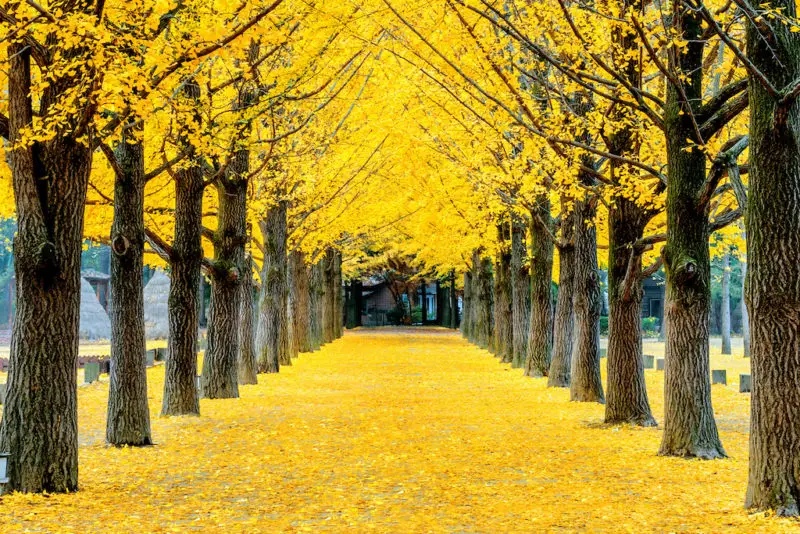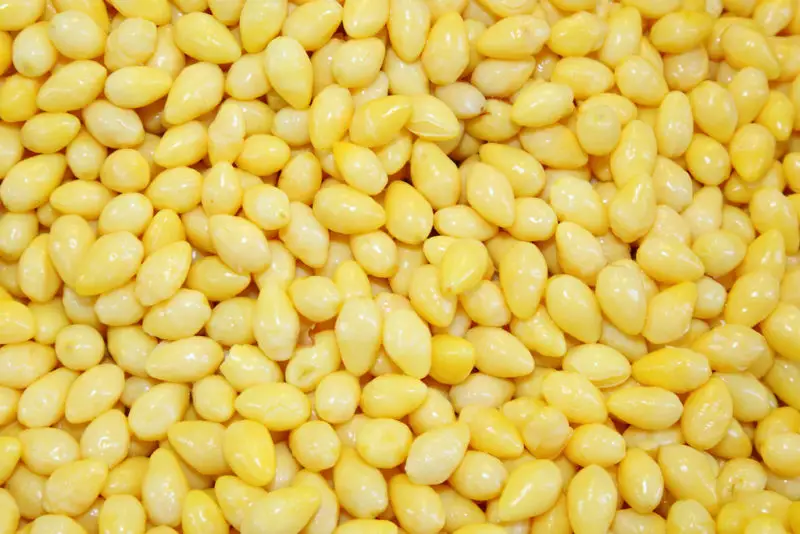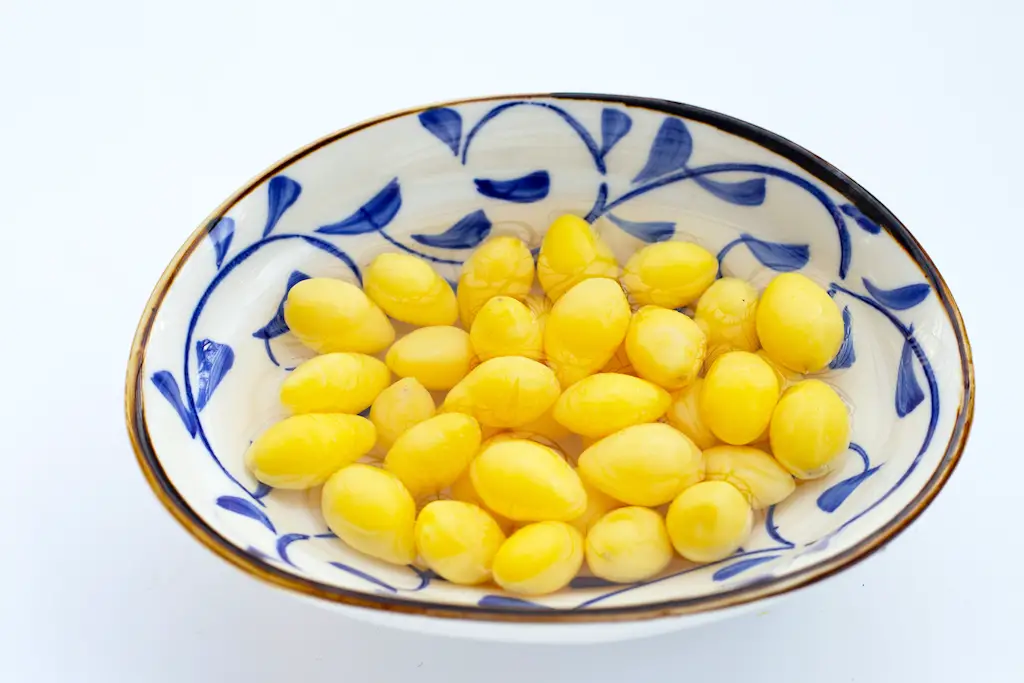This post may contain affiliate links. Please read my disclosure for details at the bottom of this page. As an Amazon Associate, I earn from qualifying purchases on this article about ginkgo nuts in Korean cooking. We hope you enjoy learning about eunhaeng.
You may have heard of chestnuts. Or, maybe you have eaten macadamia nuts…but have you ever tried ginkgo nuts? In the United States, we eat all sorts of seeds that we call ‘nuts,’ but never eat those from the ginkgo tree.
In many East Asian countries, ginkgo nuts are a traditional ingredient used in traditional cooking. Often, in China, people use these nuts as an ingredient in congee. In Japan, people use them in dishes such as chawanmushi, a steamed egg custard dish in a pot. In South Korea, people add them to dishes in the autumn months and eat them on skewers.
Here, we discuss ginkgo nuts in Korean cooking as well as answer some questions you may have about this ingredient.
What Are Ginkgo Nuts?
The Ginkgo biloba, commonly known as ginkgo, gingko, or maidenhair tree, is a species of tree native to China. The Ginkgo nut is the seed found at the center of the fruit of the female ginkgo tree.
While ginkgo trees are well known for their beautiful yellow leaves, these scenic autumn trees come at a cost! In early fall, the female ginkgo trees drop the fruits. These fruits contain toxins that naturally stink like sewer or vomit as they decompose. These days, city governments all across Asia, such as in Seoul, work hard to collect the fruits as they fall to prevent the stench from getting out of control. While unpleasant for a while, I think the beautiful fall leaves are worth it!!!
Once the fruits fall away, you can collect the nuts at the center. These nuts have a distinct flavor profile. People describe the flavor as a combination of edamame, potatoes, and pine nuts.
Ginkgo Fact: There are about 114,000 ginkgo trees in Seoul, South Korea alone! That’s a lot of trees!

Ginkgo Nuts in Korean Cuisine:
In the Korean language, ginkgo nuts are known as ‘eunhaeng’ (은행).
In South Korea, often people eat ginkgo steamed, sauteed, and roasted. Often, you can find them served on little skewers! Beyond being served on skewers, you will also find them as a garnish on different dishes during the fall. Once added as a garnish to dishes, it gives an extra nutty flavor!
Once shelled and cooked, these nuts change in color. Typically, they turn either a beautiful golden yellow or bright jade green.
Ginkgo Nuts Frequently Asked Questions:
Now that we learned about the ginkgo nut in Korean cooking, we want to answer some questions you may have about this ingredient! If we do not answer your question, feel free to leave a comment in the section below or email us at [email protected].
Where Can I Buy Eunhaeng?
Unfortunately, you cannot find this ingredient in your typical western-style grocery store. Instead, shop for eunhaeng at your local family-run Asian market or large Asian grocery chain. You will find them in the refrigerated produce section when in season. Out of season, you can often find them bagged in the frozen section.
Finally, if you own a ginkgo tree, you can forage for them in your yard. Only female ginkgo trees produce fruit. After the (very smelly) fruit ferments and falls away, you can find the nuts normally found in the center of the fruit!
Where to Buy Korean Ingredients Online?
Nowadays, there are many online options to choose from to order Korean food online. These websites are not limited to but include:
- Amazon
- H-mart
- Hanpoom
- Wooltari
How Do I Properly Store This Ingredient?
Unfortunately, fresh ginkgo nuts tend to deteriorate and grow moldy very easily, especially in humid climates. To make them last longer, store the fresh, unshelled ginkgo nuts in the refrigerator. Or, shell the nuts and store them in the freezer for a few months.

How Long Does This Ingredient Last?
In the refrigerator, unshelled, eunhaeng can keep for up to a month.
Shelled and frozen, these nuts stay fresh for a few months. Throw them away if the frozen nuts develop frostbite.
How Do I Eat Ginkgo Nuts?
Before eating ginkgo nuts, you need to properly prepare and cook them. Uncooked ginkgo nuts contain a toxin known as ginkgotoxin. This toxin causes vomiting and even loss of consciousness.
Once cooked, the level of toxins greatly decreases in ginkgo nuts. That being said, you still need to eat these nuts in moderation even after being cooked.
We Hope You Enjoyed Learning About Ginkgo Nuts!
In the end, we hope you enjoyed learning about ginkgo nuts! If so, let us know in the comment section!
If you would like to read more about cooking, you can find further recipes on our blog. We listed some of our favorite Carving A Journey Korean recipes below! For reference, many recipes are influenced by our blended Korean and Southern heritage.
Korean Ingredient Articles:
- Chrysanthemum Greens in Korean Cooking (Ssukgat)
- Dandelion Greens In Korean Cooking (Mindeulle)
- Korean Fermented Salted Shrimp (Saeujot)
- What Is a Korean Melon? (Chamoe)
- Black Sesame Seeds in Korean Cooking (Heukimja)
Further Carving A Journey Recipes:
- Dandelion Green Side Dish Recipe (Mindeulle Namul Muchim)
- Korean Spinach Side Dish (Sigeumchi Namul)
- Sukju Namul Muchim (Korean Mung Bean Sprout Salad)
- Korean Seaweed Salad Recipe (Miyeok Namul)
- Korean Soybean Sprout Salad (Kongnamul Muchim)
If you have any questions or comments, you can also email us at [email protected].
And, finally, we would love to hear from you through our social media as well! You can follow us at @carvingajourney on Instagram, Facebook, and Pinterest. I also started a vlog Youtube channel! Or, if you would like more articles like these, you can subscribe to our blog by joining our mailing list. Let us know if you try using this ingredient when cooking! Thank you so much for stopping by!
Carving A Journey is a participant in the Amazon Services LLC Associates Program, an affiliate advertising program designed to provide a means for sites to earn advertising fees by advertising and linking to Amazon.com. Although we may earn commissions for our endorsement, recommendation, testimonial, and/or link to any products or services from this website, these opinions are my own and I fully support these products.

